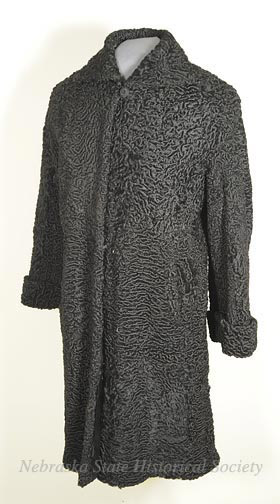
11588-263 (photograph at left).
The Nebraska History museum has a collection of clothing that spans almost 150 years. Some of these items have important stories to tell. Here is one of those stories.
In the early years of the 1930s, life for Hedwig and Bernhard “Benno” Rosenberg of Frankfurt, Germany was good. Their department store was a popular shopping destination and they enjoyed a comfortable lifestyle with their son Ludwig, his wife Ilsa and their baby granddaughter Hanna. When the Nazi party came to power in 1933, its leader, Adolph Hitler, called for boycotts of Jewish owned shops and businesses. The Rosenbergs, who were Jewish, felt their finances suffer, but remained optimistic and hoped for the best.
Ludwig Rosenberg’s father-in-law, Alfred Speier, also a Jewish business owner, (he owned the upscale “Speier’s” fabric store in Halberstadt) lamented the boycotts to his cousin who lived in Nebraska. The cousin, whom Alfred had corresponded with since childhood, traveled to Europe sometime in the mid 1930s. Alfred met his cousin in Switzerland and as he read the uncensored newspapers, he began to realize the danger his family was in.
In a 1996 interview, Alfred Speier’s youngest daughter, Eva explained that most Jewish people living in Germany in the 1930s were unaware of how bad the situation actually was. “The papers were censored, we had no idea and of course when you lived in Germany, you thought you lived in a civilized country with these great philosophers.”
Alfred’s cousin offered to help the Speiers escape to the United States. Alfred sold his fabric store and in December 1936, he moved with his wife, Kate, and 16-year-old daughter Eva to Lincoln, Nebraska, where they settled in to a house at 16th & B street. Eva attended University High School. Later in her life, she recalled the challenges of being a new immigrant. In addition to her struggle to learn English, her winter coat caused the other teens to stare. The coat, lined with hamster pelts, had been an expensive and fashionable item back home, but was one of many things that made her feel like she didn’t fit in.
For the first half of 1937, the Speiers waited nervously for Ilsa, Ludwig and Hanna to join them in Nebraska. Conditions for Jews in Germany had deteriorated and anti-Semitic laws and sentiment resulted in attacks and violence towards Jewish citizens. Eva remembered that, “it was a very difficult month waiting whether they would get out.”

11588-195. This suitcase shaped booklet from the Albert Rosenhain Leather Goods Company contains lists of items that travelers should pack for vacation. The Rosenbergs and Speiers may have consulted this booklet as they packed for their move to Nebraska. Ironically, the owner of the Rosenhain company himself escaped Nazi occupied Germany. In 1938 the store was “liquidated” by the Nazis.
Finally in August 1937, Ilse, Ludwig and Hanna arrived in Lincoln and moved in with the Speiers. Ludwig got a job working at Gold’s Department store as a buyer.
Ludwig’s parents remained in Frankfurt and despite frantic efforts to help them escape via Cuba, Hedwig and Benno Rosenberg did not make it out. They continued living in Frankfurt until September 2, 1942. On that autumn morning, Hedwig arrived at the doorstep of a trusted non-Jewish neighbor’s house carrying several of her treasured possessions. She may have known that she was about to be taken away from her home and had perhaps watched as the Nazis looted the possessions of other Jewish families. One of the things she carried that day was her black Persian lamb coat. The full-length coat was at the height of 1930s fashion and would have kept her warm all winter long. The neighbor, fearful of the looting and violence in Frankfurt, buried the coat in her backyard for safekeeping.
By the end of September 2, the Nazis came for the Rosenbergs. The older couple was put on a train headed to the Theresienstadt Jewish ghetto located in what is now the Czech Republic. From there, they were taken to Treblinka extermination camp in Poland. On September 29, 1942, Hedwig and Benno were murdered. Before the war ended, 850,000 men, women and children were killed at Treblinka.
One day after the end of World War II, a large package arrived at the house on 16th & B street. The package contained the Persian lamb coat. The Rosenberg’s neighbor had unearthed Hedwig’s beloved coat from her yard and mailed it to Lincoln. Ilsa had her mother-in-law’s coat cleaned and repaired at Mack Pachman’s Furrier in downtown Lincoln. She remembered Hedwig every time she wore the coat. Eventually she donated it to the Nebraska State Historical Society, along with a collection of household items the Speier and Rosenberg families brought with them when they escaped Germany.
The coat and other items in the Rosenberg/Speier collection help tell the story of two families who immigrated to Nebraska under horrific circumstances and started new lives.
-Tina Koeppe, Exhibit Services Coordinator



